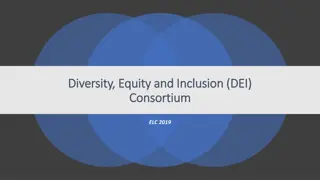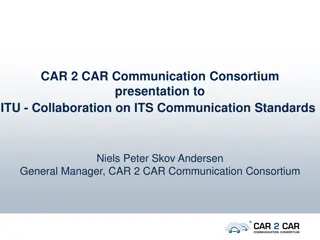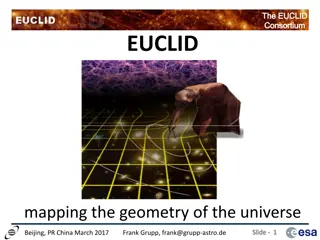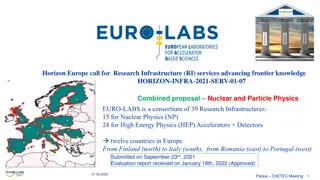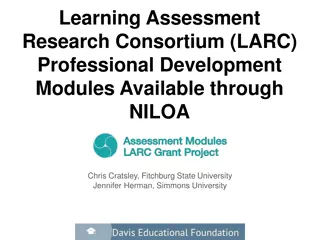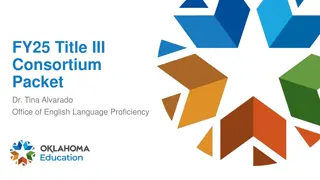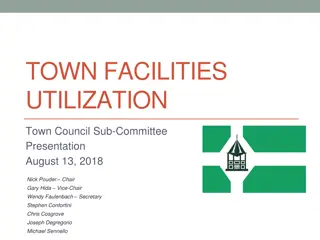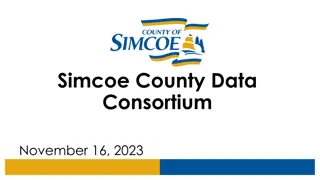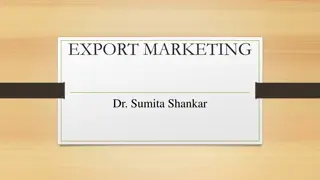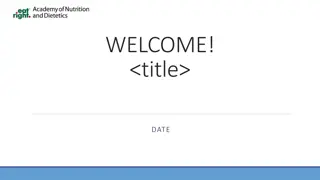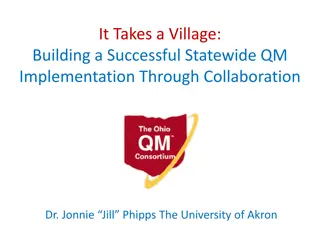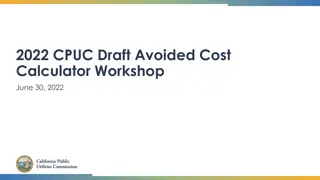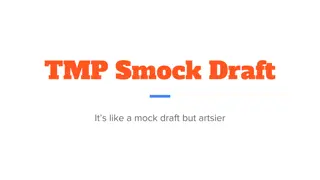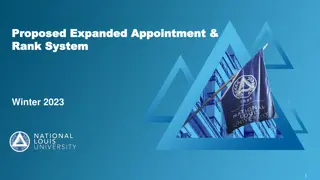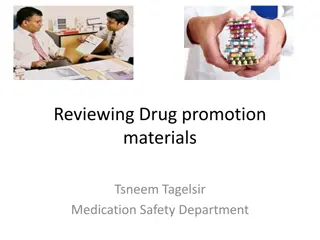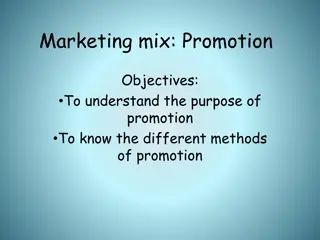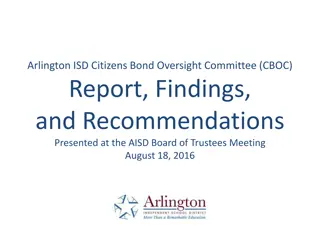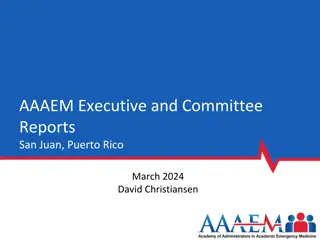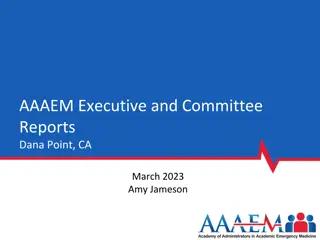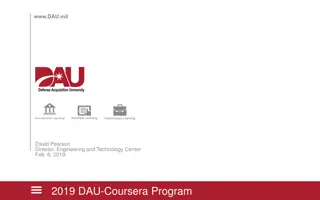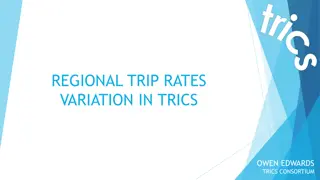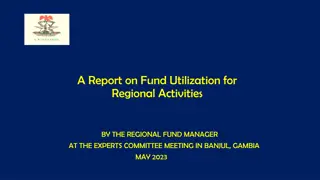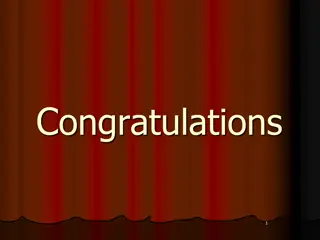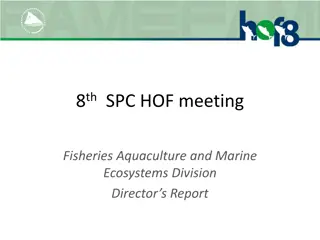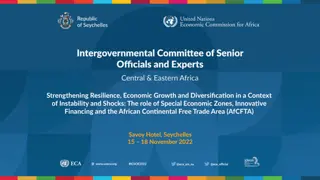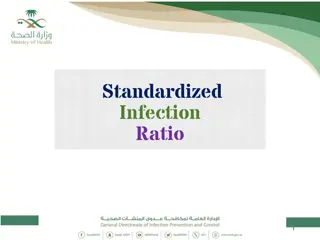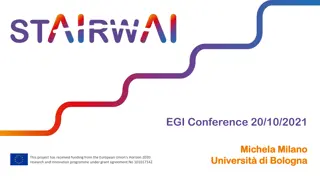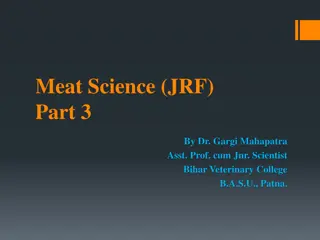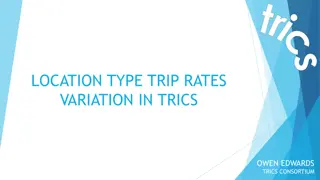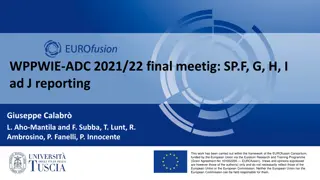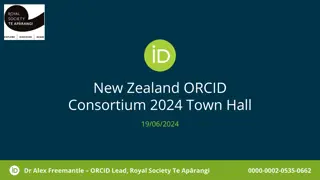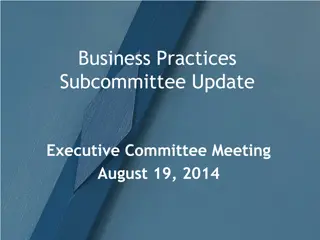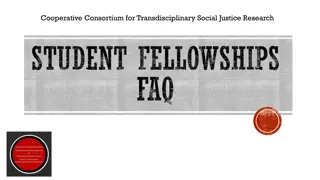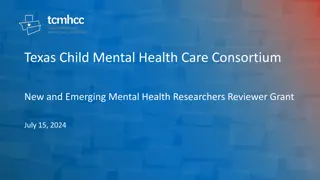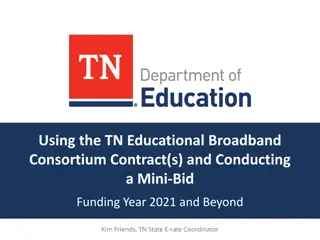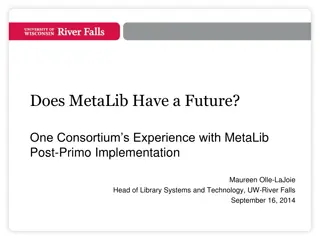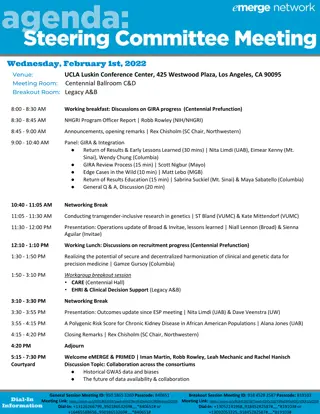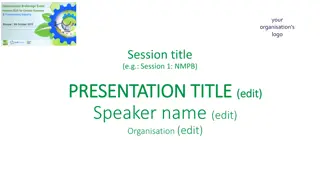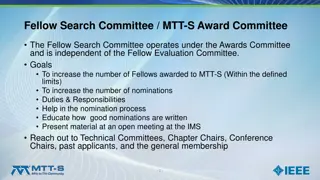Activities of Utilization and Promotion Committee in the Open Data Promotion Consortium - 2012 Draft
Activities of the Utilization and Promotion Committee in the year 2012 draft include information dissemination on open data, development of examples of open data utilization, and consideration of issues related to open data promotion. Events like organizing symposiums, ideathons, and hackathons are planned to enhance open data utilization. Reference materials and data examples are provided for further implementation.
Download Presentation

Please find below an Image/Link to download the presentation.
The content on the website is provided AS IS for your information and personal use only. It may not be sold, licensed, or shared on other websites without obtaining consent from the author. Download presentation by click this link. If you encounter any issues during the download, it is possible that the publisher has removed the file from their server.
E N D
Presentation Transcript
Ref. 5 Open Data Promotion Consortium Utilization and Promotion Committee 1stMeeting Issues for Consideration and Procedure of the Year 2012 (Draft) September 28, 2012 Secretariat of the Open Data Promotion Consortium
Contents 1. Activities of Utilization and Promotion Committee in the Year 2012 (Draft) - - - - 3 2. Major Themes for Consideration of Each Meeting (Draft) - - - - - - - - - - - - - - - - - 6 3. Schedule of the Year 2013 (Draft) - - - - - - - - - - - - - - - - - - - - - - - - - - - - - - - - - 7 (Reference) Reference 1. Data Examples for Posting on the Open Data Catalogue (incl. links) - - - - - - - -8 Reference 2. Introduction of Good Practices as Useful Reference (Information Provision by Members, etc.) - - - - - - - - - - - - - - - - - - - - - 9 Reference 3. Where does my money go ? - - - - - - - - - - - - - - - - - - -- - - - - - - - - - 13 Reference 4. Approaches from Different Fields and Technologies (Examples)- - - - 14 2
1. Activities of Utilization and Promotion Committee in the Year 2012 (Draft) 1 Information Dissemination on Open Data 2 Development of Examples of Open Data Utilization 3 Consideration of Issues related to Open Data Utilization Promotion 1 Information Dissemination on Open Data 1 1) Information Dissemination by a Portal Site (See the Reference 1, 2) (Examples) Meanings and Effects of Open Data Examples of Open Data Utilization Open Data Catalogue (Data provided by Committee Members or Observers. Linkages to the Standard API which is to be created later may also be included.) Information of Activities of Committees of Utilization & Dissemination, Technical, and Data Governance (Outline of Proceedings, Delivered Materials etc.) Relevant Movement of the Government and Local Authorities Information provided by Committee Members Event Information related to Open Data 2) Organization of Symposium Organization of a Symposium with 200 to 500 participants in Japan (Tentatively Scheduled in the afternoon of Dec. 10 (Mon), 2012) Objectives of the Symposium a) Provision of the Latest Information of Open Data b) Recognition Enhancement for Those related to Open Data (Data Owners, Service Developers and Providers, etc.) Symposium Contents (Draft) Keynote Speech, Introduction of Open Data Utilization, Introduction of Activities of Consortium Committees, Panel Discussion) 3
1. Activities of Utilization and Promotion Committee in the Year 2012 (Draft) (2) Development of Examples of Open Data Utilization 1) Organization and Support to Ideathon and Hackathon Organization of an Ideathon and a Hackathon with the theme of Utilization of the Government-Owned Open Data (Example : Data owned by the Meteorological Agency) Organization of an Ideathon and a Hackathon with the theme of Utilization of the Verification Project Data (Example : Geological Data) 2) Development of Examples of Open Data Utilization Making Use of the Data provided by Committee Members (See the Reference 3,4) Based on the data posted on the Open Data Catalogue created in the afore-mentioned (1), Committee members etc. may freely consider the usage, and develop pilot app. or services. The developed results are posted on the Open Data Catalogue. In addition, theme-based programs may be promoted. (Ideas of Programs) a) Where does my money go? Making use of the website for visualization of budget execution, and in collaboration with the Committee Member local authorities, plural websites for budget execution visualization may be created and introduced. This may be undertaken in collaboration with the team which has already created the Yokohama City version (in which Mr. Kawashima of the Committee participated). b) Transforming the Basic Data of Local Authorities into Open Data (This is relevant to the Open Data Catalogue of (1) above.) In collaboration with the Member local authorities, basic data including population, industries, etc. of plural municipalities may be transformed into the ones that are machine-readable and suitable for comparative analysis, and be posted open to the public. The standard API which is to be considered by the Technical Committee may be incorporated to the extent possible. c) Approaches from Issues of different fields, and from the latest technological development Through hearings from experts of the fields where open data utilization may be prospective, as well as from those involved in the latest technological development, the consideration of possible open data utilization and promotion may be made. d) Others Other programs may be considered through the discussion of the Committee. 3) Cooperation and Support to Open-Data-Related Events Support to Open-Data-related events held by other organizations (Ideathon, Hackathon, Contest, Symposium, etc.) 4) Contest (Commendation at the Committee s Discretion) Excellent app. or services created at the Consortium s Hackathon or at contests etc. of other organizers will be commended at the Committee s discretion. 4
1. Activities of Utilization and Promotion Committee in the Year 2012 (Draft) 3 (3) Consideration of Issues related to Open Data Utilization Promotion 1) Consideration from the Viewpoint of Business Feasibility Requirements Based on the hearing results mentioned in the previous page, cases of open data which produce benefits may be considered. (Examples) a) Making individual data open, and assembling them into the one which works as the benchmark and brings about new value. Child-Rearing Data of Benesse s Women s Park Karada Karte (Clinical Records) of Tanita Corporation, Karada Life (Medical Records) of Fujitsu Runners Data of Nike Nike+ Efforts of standardization of policy measure data of local authorities by a non-profit organization, Asukoe (Comparison of Child- Rearing Support Services, etc.) b) Once data are made open, they are utilized and analyzed in combination with other data, which then produce benefit to the data owners. Making river water level data owned by municipalities open allows further use of data in combination with other river-related meteorological information administered by other local authorities and the central government. The combined data can be used for measures of prevention of floods. Making meteorological data of agricultural lands owned by vineyard holders open allows research institutions to forecast the pest outbreak time, and to give appropriate advice of pest control to farmers. 2) Collaboration with Technical and Data Governance Committees Providing inputs to the two Committees from the viewpoints of data utilization and dissemination. (Example) Users views and requests concerning the technical standards and guidelines. (in terms of convenience for use, etc.) Getting inputs from the two Committees regarding the solutions of issues in connection with data utilization and dissemination. (Example) Ideas of standards and licenses for data description format and vocabularies, as well as the early provision of the first version of the reports etc. of the two Committees. 5
2. Major Themes for Consideration of Each Meeting (Draft) Date of Meeting Topics of Discussion a) Introduction of Participants, Procedure of the Committee, Schedule (Secretariat) b) Introduction of Cases of Open Data Utilization Case of Hackathon at GLOCOM (Mr. Shoji, Deliberative Member of the Committee) Where does my money go? Approach of Yokohama City (Mr. Kawashima, Committee Member) Approach of Yokohama City for Open Data (Mr. Sekiguchi, Yokohama City) c) Free Discussion Way of Proceeding of the Committee Programs to be Undertaken by the Committee a) Case of Open Data Utilization and Possibilities (Guest Speaker) b) Report of the Hearing Survey Results (Secretariat) c) Report of State of Progress of Each Program (Officers in charge of Programs) d) Free Discussion Making Government Data Open Business Feasibility Requirements of Open Data a) Report of Progress of the Technical and Data Governance Committees (Secretariat) b) Introduction of Verification Project (Ministry of Communications) c) Report of State of Progress of Each Program (Officers in charge of Programs) d) Free Discussion Opinions to the Technical and Data Governance Committees from the Viewpoints of the Open Data Utilization & Dissemination Business Feasibility Requirements of Open Data Commendation of Excellent Examples of Open Data at the Discretion of the Committee Collection of Cases by the Secretariat. Examination of the Cases by the Committee, and Commendation a) Prize Awarding Ceremony (Senior Researcher & Prize-Awardees) b) Report of Progress and Achievements of the Year of Each Program (Each Program Officer) c) Summing Up of Achievements of the Year (Cases of Open Data Utilization, Business Feasibility Requirements, etc.) (Secretariat) d) Report of Activities of the Year and Plan of Activities of the Next Year (Secretariat) 1stMeeting Sept. 28 (Fri), 2012 15:00 -17:00 2ndMeeting Nov. 7 (Wed), 2012 13:00 -15:00 3rdMeeting Jan. 22 (Tue), 2013 13:00 -15:00 Evaluation for Commendation (e-mail exchange) 4thMeeting Mar. 13 (Wed), 2013 10:00 -12:00 6
3. Schedule of the Year 2013 (Draft) Adding Information Sequentially Information Dissemination by Portal Site Organization of Symposium Symposium (Tentative) 2nd (Verification Project (Geology) Data Utilization, etc. 1st (Meteorological Agency Data Utilization etc.) Organization of Idea-Thon & Hack-a-Thon Hearing (Secretariat) Creation of Cases of Utilization of Open Data Provided by Committee Members Planning & Implementation of Each Program Collaboration & Support to Open-Data-Related Events Examination Collection of Examples of Open Data Utilization Contest (Commendation at the Committee's Discretion) PrizeAwarding (at the 4th Meeting) Consideration of Business Feasibility Requirements Consideration of Business Feasibility Requirements Collaboration with Technical and Data Governance Committees Responding as needed 7
Reference1. Data Examples for Posting on the Open Data Catalogue (incl. links) Reference1. Data Examples for Posting on the Open Data Catalogue (incl. links) 1) Government Ministries (Observers) In consultation with the Technical Committee, and selected from data made open to the public by government ministries, appropriate data will be posted after transforming them into RDF form. (Examples) Common to All Ministries Information of Budget / Settlement, Procurement, Laws & Ordinances, Press Release, etc. Min. of Communications Communications Statistics, Financial Situations of Local Authorities, Statistics of Local Tax, etc. METI, Min. of Environment Intensity of Solar Radiation, Wind Energy Map, Biomass Abundance, Environment Statistics MLITT, Meteorological Agency, Tourism Agency Meteorological Statistics, Disaster Prevention Statistics, River Water Level, Map Information, Traffic Volume, Barrier Free Map, etc. MAFF Agricultural, Forestry & Fisheries Statistics (Production Volume by Crops etc.), Rural Community Information, etc. 2) Member Local Authorities In consultation with the Technical Committee, and selected from basic data of local authorities, appropriate data will be posted after standardization and transforming them into RDF form. (Examples) Basic Information including Population & Households, Area, Latitude / Longitude, City Flower, City Emblem, etc. Shelter Information Address, Latitude / Longitude, Facilities Title (Official and Common Names), Targeted Areas, Accommodation Capacity, Disaster Stockpile Items, etc. Public Facilities Information (Schools, Kindergartens, Hospitals, Toilets, etc.) Address, Latitude / Longitude, Facility Outline Map Information (City Planning Map etc.) Information related to Life (Garbage Collection Calendar, Administrative Services Information, etc.) Tourism Information (Tourism Facilities, Events, Transportation, Tourist Maps, Photos, etc.) 3) Participating Organizations in the Verification Project Out of data earned or utilized in the verification project, those data that can be made open to the public are transformed into RDF form, and will be posted. (Geology, Traceability, Traffic Data, etc.) 4) Committee Member Corporations and Organizations Out of data owned by the Committee members, those data that can be made open to the public and deemed useful for the society as a whole will be posted. 8
Reference 2. Introduction of Good Practices as Useful Reference Reference 2. Introduction of Good Practices as Useful Reference (Information Provision by Members, etc.) (Information Provision by Members, etc.) Example Introduction of Location Information Service Research Agency (Lisra), NPO Nobuo Kawaguchi, Representative Director, Lisra, NPO / Professor, Nagoya University Foreword Thanks to the recent spread of portable terminals and advancement of positioning technology, diverse services relying on positioning system are getting popular. Research and development activities related to positioning-based services have been also active. However, most of individual research results are constrained due to operational and budgetary reasons, and rarely translated into actual services. Even if verification experiments are implemented, the continuous operation is often difficult. In addition, location-based services, either utilizing Crowd-Sourcing (volunteers) with a focus on selected fields, or specializing in area-specific data with the involvement of local authorities have been simultaneously emerging. However, since data exchanges among those services have been virtually absent, users have to separately select the necessary services. Significance of the Establishment of the Non Profit Organization We have established Location Information Service Agency (Lisra) as a specified non-profit organization. The objectives are the enlightenment of application and advancement of positioning-based technology for wide range of usage, the contribution to the society and the industrial development through the support to the research, development, education, promotion of the positioning-based technology as well as volunteers who register positioning information. The presence of a quasi-public organization with juridical personality is crucially important for research and promotion of location-based information services in terms of information sharing, service aggregation, and ensuring consistency. We wish that Lisra would function as the hub to compile and distribute location-based information. We aim at being an mediator among volunteers, local authorities, public transportation and public sector businesses for distribution of location-related information as the new publicgoods . We would like to particularly consider the means of utilization of various location information owned by the government and local authorities. We need sound technological foundation for the provision of location information services. Lisra would pursue the research and development of the latest technology, and share the results among the members. There exist varied issues regarding positioning- based advertisement, POI (Place of Interest), indoor location information etc. Lisra would pursue the technological possibility through series of verification experiments. The planning of these experiments and sharing of the experiment results are based on the discussion among members. We would like to be the organization which the latest location information and the most advanced members gather. Operation of the Corporate Body and the Symposium Lisra as the corporate body is operated by the Board of Directors, Management Committee, and General Assembly. It sets up various working groups for research and development. The symposium commemorating the establishment of Lisra is scheduled to be held on Dec.1 (Sat.), 2012. Necessary information will be sent through the mailing list of information exchange in due course. Your participation is greatly appreciated. Contact for Details : http://lisra.jp Email : info@lisra.jp 9
Reference 2. Introduction of Good Practices as Useful Reference Reference 2. Introduction of Good Practices as Useful Reference (Information Provision by Members, etc.) (Information Provision by Members, etc.) Example Collection & Distribution of Location Information and Support to Volunteers Nobuo Kawaguchi, Representative Director, Lisra, NPO / Professor, Nagoya University Through the experiences of Locky.jp which is the iPhone app. used by more than 1.3 million users, we have confirmed the effectiveness of a framework in which users participate for the utilization of location information. Locky.jp which achieved the collection of more than 1 million data, and Station.Locky Station.Locky Circle of Service Provision Circle of Service Provision and Data Collection and Data Collection Private Sector Businesses Private Sector Businesses Niche Location Information Services Private Sector Location Information Services High Geospatial Information Volunteers General Users If feasibility is high, commercialization will be possible. Profitability Service Provision Data Registration Lisra s Target Crowd Sourcing System Good quality service provision invites more volunteers to participate in the system. Location Information Service Verification Experiment of Location Information Services Location Information Services by Volunteers Data Conver sion Low NPO Research Institution Small Large Scale 10
Reference 2. Introduction of Good Practices as Useful Reference Reference 2. Introduction of Good Practices as Useful Reference (Information Provision by Members, etc.) (Information Provision by Members, etc.) Example Establishment of Non-Profit Organization as New Public Goods Ownership Ownership of Collected Data Contracts Contracts with other Corporations Consistency & Continuity Consistency & Continuity of Business Public Interest Public Interest as a NPO Merits of Incorporation We established a specified non-profit organization, Location Information Service Research Agency Information Service Research Agency, in September 2012, for implementation of businesses that are difficult both for private businesses and local authorities. The businesses are to be implemented by Geospatial Information Volunteers Geospatial Information Volunteers to whom Lisra would provide support. Objectives of the Corporate Body Objectives of the Corporate Body Location Aiming at being the Distribution Hub of Aiming at being the Distribution Hub of Geospatial Information Geospatial Information Private Sector Businesses Public Transport Facilities Research & Development Research & Development of technology and services related to location information Education and Promotion Education and Promotion of technology of location information Support to volunteers Support to volunteers who register location information Public Offices Private Sector Businesses Business Contents of the Corporate Body Business Contents of the Corporate Body Data Provision Data Provision 1. Provision of Information & Services Provision of Information & Services related to location information 2. Organization of symposia and seminars related to location information 3. Development & Development & Experiments Experiments related to location information 4. Collection, Provision and Distribution Distribution of location information & location-reliant information 5. Support to Volunteers Support to Volunteers engaged in location information 6. Other activities necessary for achieving the objectives of the corporate body Geospatial Information Volunteers 11
Reference 2. Introduction of Good Practices as Useful Reference Reference 2. Introduction of Good Practices as Useful Reference (Information Provision by Members, etc.) (Information Provision by Members, etc.) Example Experiment of Location Information Services Location-reliant advertisement utilizing a banners area of Station.Locky Various experiments utilizing data of 100,000 persons / day are possible. Examination of varied parameters changing place, time and contents Creation of a software platform for location-reliant advertisement Preparation of tools for visualization of results Inviting ideas of experiments from Lisra members (Inviting advertisements for experiments as well) Merits of being Regular Members Merits of being Regular Members They can participate in Lisra s decision- making process. They can be selected as participants of experiments, etc. Lisra Member Types Regular Member, Entrance Fee 50,000 yen, Annual Fee 50,000yen / share Individual Regular Member Regular Member, Entrance Fee 10,000 yen, Annual Fee 10,000 yen / share Associate Member, Entrance Fee Nil, Annual Fee 2,000 yen / share Corporate Special Member, Entrance Fee Nil, Annual Fee 20,000 yen / share Individual Special Member, Entrance Fee Nil, Annual Fee Nil Lisra, NPO is currently preparing for various activities. We are particularly interested in the data collaboration with private sector businesses and public transport facilities. Various verification experiments utilizing Station.Locky are also parts of our agenda. Looking forward to your contact to us. Corporate Regular Member Contact Location Information Service Research Agency, NPO Email : info@lisra.jp URL: http://lisra.jp Facebook : http://www.facebook.com/lisra.jp Twitter : @LisraJ
Reference 3. Where does my money go? An open source app. for visualization of the use of tax money created by Open Knowledge Foundation (UK). A volunteer team created the Yokohama City version on July 2, 2012 at the Hackathon organized by GLOCOM, International University of Japan. UK website Yokohama City Version (See below) http://wheredoesmymoneygo.org/ http://spending.jp/ 13
Reference 4. Approaches from Different Fields and Technologies (Examples) Reference 4. Approaches from Different Fields and Technologies (Examples) 1) Approach from Different Fields Undertaking hearings from experts of major fields where open data utilization is highly expected (weather, geology, hygiene, economy, public administration, transport, etc.), and getting familiar with the prospects of issue solutions owing to open data, and business feasibility requirements. (Candidates for Hearings) Physical Data of weather, geology, satellite photos etc. Economic Statistics Weather News Inc. Mr. Hideyuki Tanaka, Interfaculty Initiative in Information Studies, Graduate School of Interdisciplinary Information Studies, the University of Tokyo Mr. Sakashita, JIPDEC and Mr. Yoshihide Sekimoto, Center for Spatial Information Science, the University of Tokyo Public Service Information Mr. Kawashima, Deliberative Member of the Committee Transport Information Jorudan, Navitime Medicine & Healthcare Information Mr. Komiyama, Chairman of MRI Map Information 2) Approach from Different Technologies Considering possibilities of open data utilization from the viewpoints of the latest technology trends. (Candidates for Hearings) Censor Information (M to M) Advisor, Mr. Sakamura, Advisor, Mr. Tokuda, Mr. Koshizuka, Senior Researcher, Technical Committee IBM Japan, Japan PFI Enterprise Cases of Introduction of Data Mining Technology Deep Impact Co., Ltd (Pharmaceutical Industry), Plus Alpha Consulting Co., Ltd (Marketing) Visualization of Patent Information Nomura Research Institute Social Media Hottolink Inc., CGM Marketing Co. Flow of People NTT DOCOMO Inc., Mr. Yoshihide Sekimoto, Center for Spatial Information Science, the University of Tokyo Big Data Analysis Technology 14



